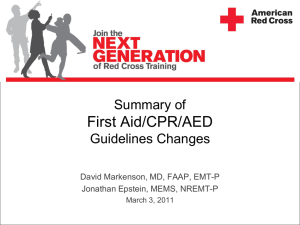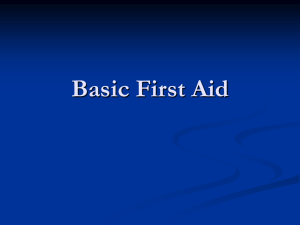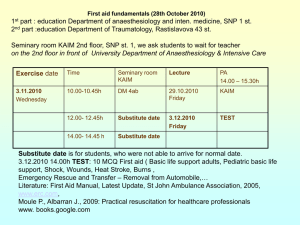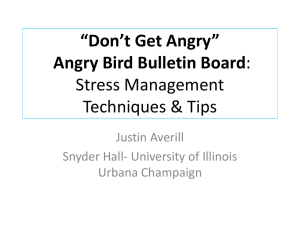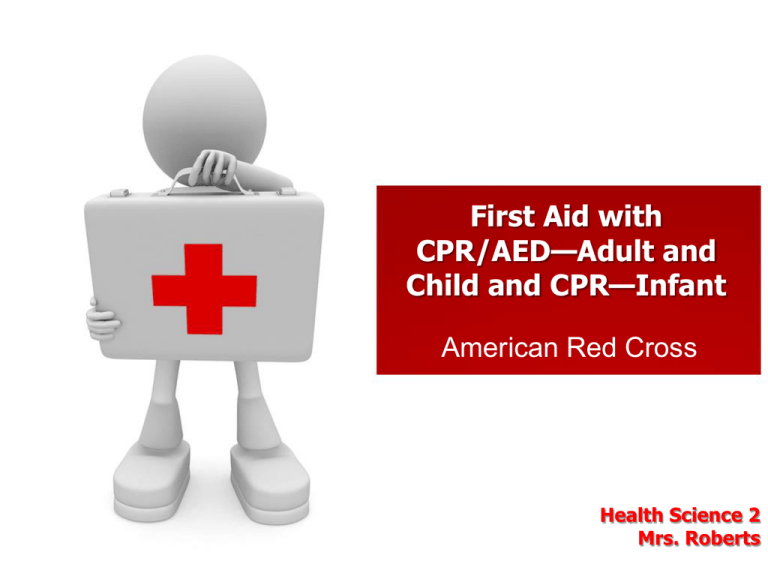
First Aid with
CPR/AED—Adult and
Child and CPR—Infant
American Red Cross
Health Science 2
Mrs. Roberts
Certifications
• Standard First Aid (Valid for 3 years)
• Adult/Child/Infant CPR & Adult AED (Valid
for 1 year)
Expectations
• Attend ALL class sessions or make up
missed sessions
• Demonstrate competency in all required
skills
• Participate in all skill sessions and
scenarios
• Score at least 80% on each section of the
written exam
LESSON 1:
BEFORE GIVING
CARE
Recognizing and Responding to
an Emergency
• By recognizing an emergency and taking
immediate action to help, you give a suddenly
ill or injured person the best chance for
survival.
• Emergencies can often be recognized because
of unusual sights, appearances, behavior, odors
or noises.
Overcoming Barriers to Act
• There are many reasons why bystanders do not get
involved in an emergency situation.
• It is normal to feel hesitant or unsure about what to
do.
Good Samaritan Laws
• Enacted in all states to protect people who voluntarily
give emergency care, without accepting anything in
return.
• May protect you from legal liability as long as you–
–
–
–
Act in good faith
Are not negligent
Act within the scope of your training
Never abandon a person once you start care
• You MUST OBTAIN CONSENT to help an ill or injured
person
Obtaining consent
•
•
•
•
•
State your name
Tell the person you are trained in first aid
Ask the person if you can help
Explain what you think may be wrong
Explain what you plan to do
“DO NOT give care to a conscious
person who refuses it”
Preventing Disease Transmission
• Standard Precautions (AKA “Universal Precautions”)
– Avoid contact with blood or other body fluids
– Avoid touching objects that may be soiled with
blood or other body fluids
– Place barriers between you and the injured or ill
person
– Wash your hands immediately after giving care
with soap and water
Cleaning up a Blood Spill
• Clean immediately
• Use disposable gloves and paper towels to
clean up the area
• Flood the area with 1 ½ cups of liquid chlorine
bleach mixed in 1 gallon of water
• Let it stand for 10 minutes
• Dispose in a biohazard bag
SKILL PRACTICE:
Removing Gloves
Emergency Action Steps
Check
Call
Care
When to CALL first
• Unconscious adult or adolescent age 12 or
older
• Witnessed sudden collapse of child or infant
• Unconscious infant or child known to be at
high risk for heart problems
When to CARE first
• Unwitnessed collapse of an unconscious
person younger than 12
• Any victim of drowning
Moving an Injured or Ill Person
• “Do No Further Harm”
• Remember CHECK—CALL—CARE
• Emergency Moves
– Walking Assist
– Pack-Strap Carry
– Two-Person Seat Carry
-- Clothes Drag
-- Blanket Drag
-- Foot Drag
LESSON 2:
CHECKING AN ILL
OR INJURED
PERSON
Checking a Conscious Adult
• When it comes to first aid, an “Adult” is someone
who is about 12 years of age or older
• After checking the scene, you should check the adult
first for life-threatening conditions.
• Obtain consent to give care
• A head-to-toe examination should be done to check a
conscious adult
• Care for the person based on their condition
• Take steps to minimize shock
Checking a Conscious
Child or Infant
• For first aid, a “child” is someone who is about 1 to 12 years old.
• For the use of a pediatric AED, a child is someone between the
ages of 1 and 8 or weighing less than 55 pounds.
• For first aid, an “infant” is someone who is less than 1 year old.
• Check the scene then check the child for life threatening
conditions.
• Obtain consent from a parent or guardian, if present.
• Care for the child base on their condition
• Take steps to minimize shock
Recognizing and Caring
for Shock
• Likely to develop after any serious injury or illness
including severe bleeding, serious internal injury,
significant fluid loss or other conditions.
• A person showing signs of shock needs immediate
medical attention.
• Body systems and organs begin to fail.
• Goals of first aid get help quickly and give care to
minimize shock
Signs of Shock
•
•
•
•
•
•
Restlessness or irritability
Altered level of consciousness
Nausea or vomiting
Rapid breathing and pulse
Pale or ashen, cool, moist skin
Excessive thirst
Care Steps for Shock
•
•
•
•
•
CALL 9-1-1
Monitor the person’s ABCs
Control any bleeding
Keep person from getting chilled or overheated
Elevate legs about 12 inches (ONLY if you don’t
suspect a neck, back or hip injury)
• Comfort and reassure (Do not let them eat or drink
anything)
Checking an Unconscious Adult
Remember your ABCs
A = Airway
B = Breathing
C = Circulation and severe
bleeding
Checking an Unconscious
Child or Infant
• Again, Remember your ABCs
• With a child or infant, you should check for a
pulse.
– Child – Carotid pulse
– Infant – Brachial pulse
LESSON 3:
BREATHING
EMERGENCIES
AND CONSCIOUS
CHOKING
Breathing Emergencies
• Respiratory distress: having trouble breathing
• Respiratory arrest: can not breath at all
• Very important to recognize breathing emergencies in
children and infants before the heart stops beating.
– Adults hearts stop because they are diseased.
Children and Infant’s hearts are usually healthy
and stops because of a breathing emergency.
Conscious Choking Adult, Child
and Infant
• Choking is a breathing emergency that can lead to
death if not cared for immediately.
• A person is choking only when their airway is
completely obstructed.
• Universal sign of choking = clutching the throat
• Care involves 5 back blows and chest thrusts for
infants and 5 back blows and 5 abdominal thrusts for
adults
LESSON 4:
RESCUE
BREATHING
Rescue Breaths - Adult
• Process of breathing air into a person who is not
breathing to provide vital organs including the brain a
constant supply of oxygen.
• Each breath should last about 1 second. With each
breath, watch the chest clearly rise and fall.
• Blow just enough air to make the chest rise.
Rescue Breathing—Child
• Respiratory arrest can lead to cardiac arrest if not
cared for immediately.
• Given to a child or infant who is not breathing but has
a pulse.
• Give 1 breath every 3 seconds and check for signs of
life every 2 minutes (about 40 breaths).
Rescue Breathing—Infant
• Do not tilt the head back at all. Keep in a neutral
position.
• Give 1 breath every 3 seconds, checking for signs of
life about every 2 minutes.
• Make a seal over infant’s mouth and nose.
Rescue Breathing
• Continue rescue breathing on a child or infant:
– As long as they have a pulse but still not breathing
– Until help arrives and takes over
– The child or infant begins to breath on their own
– Scene becomes unsafe
– You become too tired to continue
LESSON 5:
CARDIAC
EMERGENCIES
Recognizing a Heart Attack
• Heart attack – when the heart muscle is
damaged from a lack of oxygen and blood
supply by either disease or trauma.
• A heart attack can lead to cardiac arrest.
• Cardiac arrest – heart stops functioning
altogether
CPR??
• C =Cardio = Heart
• P = Pulmonary = Lung
• R = Resuscitation = Restore life
Cardiac Chain of Survival
• CPR alone is not enough to help someone survive
a cardiac arrest
• Greatest Chance of Survival
Defibrillation
• An electric shock that interrupts the heart’s
chaotic electrical activity.
• AED = automated external defibrillator
– Analyzes heart’s electrical rhythm and, if
necessary, prompts the responder to deliver
a shock.
LESSON 6:
CPR AND
UNCONSCIOUS
CHOKING
CPR - Adult
• Cardiac Arrest: Unconscious, not breathing
and show no other signs of life.
• CPR can help circulate blood that contains
oxygen to vital organs by a combination of
chest compressions and rescue breaths.
CPR - Child
• Children rarely suffer a cardiac emergency. They suffer a
respiratory emergency that develops into a cardiac emergency.
• Common causes of respiratory emergencies that develop into
cardiac emergencies:
–
–
–
–
–
–
–
Motor vehicle crashes
Drowning
Obstructed airway
Smoke inhalation
Poisoning
Falls
Firearm injuries
CPR - Infant
• Cardiac emergencies are RARE in an otherwise
healthy infant.
• Usually preceded by trauma or a breathing emergency
or SIDS.
• Genetic or congenital problems may increase an
infants risk of a cardiac emergency.
Unconscious Choking
• If rescue breaths do not go in, you must act
quickly to get air into the person.
• Similar to CPR, except you look for a foreign
object between compressions and breaths.
• Chest compressions are used to help force air
from the person’s lungs to dislodge the object.
LESSON 7:
AED - ADULT
AED
• Automated External Defibrillator
• AED analyzes the heart’s electrical rhythm
and, if necessary, prompts you to deliver a
shock to a victim of sudden cardiac arrest.
• This shock, called defibrillation, may help the
heart to re-establish an effective rhythm.
AED Precautions
•
•
•
•
•
•
DO NOT touch the victim while the AED is analyzing.
DO NOT touch the victim while the device is defibrillating.
Make sure no one is touch the person.
Do not use alcohol to wipe the victim’s chest.
Do not use if a person is wet or lying in water.
Do not use adult pads on a child under age 8 or less than 55
pounds.
• Remove any medication patches.
• Do not use a cell phone within 6 feet of the AED.
FIRST-AID:
SOFT TISSUE
INJURIES
First Aid
• Immediate care that is given to the victim of an injury
or illness to minimize shock
• STAY CALM
• AVOID PANIC
• Evaluate the situation THOROUGHLY
2 Basic Types of Injuries
• Soft Tissue
– Layers of skin, fat and muscle
• Musculoskeletal
– Muscles, bones and joints
Soft Tissue Injuries
• Layers of skin, fat and muscle.
• Wound: physical injury that damages the layers of the
skin
– Open: break in the skin or mucous membrane
– Closed: no break in the skin or mucous membrane
but injury occurs in the underlying tissues
• Bruise (contusion or ecchymosis)
• Hematoma
Signs of Internal Bleeding
• Tender, swollen, bruised or hard area of the body,
such as the abdomen
• Rapid, weak pulse
• Cool, moist, pale, or bluish skin
• Vomiting or coughing blood
• Excessive thirst
• Becoming confused, faint, drowsy or unconscious
Treatment of Closed Wounds
• Apply direct pressure
• Elevate if it does not
cause more pain
• Apply ice or cold pack
Bruise Healing Process
Open Wounds
•
•
•
•
Abrasion: skin scraped off, bleeding limited
Incision: cut caused by a sharp object
Laceration: tearing of tissues by excessive force
Puncture: caused by a sharp object such as a pin, nail,
pointed instrument
• Avulsion: tissue is torn or separated from the victim’s
body
• Amputation: body part is cut off
Care for a Minor Open Wound
1. Wash hands!!!!
2. Wear gloves
3. Apply direct pressure to control bleeding by using a
sterile dressing
4. Wash wound with soap and water. (irrigate for 5 minutes
with clean running tap water)
5. Apply triple ABX ointment (Neosporin)
6. Cover with a sterile dressing and a bandage IF it is still
bleeding or may come in contact with dirt or germs
7. Wash you hands immediately after completing care.
Care for a Major Open Wound
• Wash hands
• Wear gloves
• Control bleeding by applying direct pressure with a
sterile dressing
• Apply a bandage snugly over the dressing
• Call 9-1-1
• Wash your hands immediately after completing care
Stitches?
• Advantages
– Speed up healing process
– Lesson chance of infection
– Improve appearance of scars
• When are they needed?
–
–
–
–
Bleeding from artery or uncontrolled bleeding
Edges of skin do not fall together
Wound would leave obvious scar on face
Wound over ½ inch long
When to call 9-1-1
• Trouble breathing
• Uncontrolled bleeding
• c/o severe pain or cannot move a body part without
pain
• If you think the force of the injury caused serious
damage
• SKILL: Controlling Bleeding
Burns
• Causes
–
–
–
–
Heat (thermal)
Chemicals
Electricity
Radiation (sun)
• Types of burns
– Superficial Burns (1st degree)
– Partial Thickness (2nd degree)
– Full Thickness (3rd degree)
st
1
Degree Burns
nd
2
Degree Burns
rd
3
Degree Burns
Skin Graft
Caring for Burns
Caring for Burns
• COOL and COVER all burns
• Chemical burns: continue flushing for 20 minutes or
until EMS arrives
– Will continue to burn as long as chemical is on
skin
• Electrical burns: may affect heart’s rhythm
– Be prepared to give CPR and use an AED
• Radiation burns: aloe cream or spray
– Avoid further sun exposure; use sunscreen
What NOT to do:
•
•
•
•
DO NOT Apply ice or ice water
DO NOT Break blisters
DO NOT Use any type of ointment on a severe burn
DO NOT Remove clothing that is stuck to the burned
area
• DO NOT Try to clean a severe burn
When to call 9-1-1
• Burns that cover more than one body part or a large
surface area
• Burns to the airway
• Child < 5, Elderly > 60
• Burns resulting from chemicals, electricity or
explosions
Lightning
Precautions to take
during a Thunderstorm
• Stay inside a building with 4 solid walls that is
grounded
• If inside car, roll up windows and do not touch metal
• Stay away from water
• Stay away from telephones except in emergencies
• Stay away from hilltops
• Stay away from metal
Care for Special Situations
• DO NOT remove embedded objects
• Small foreign object in eye; flush with water
• Severed body part: wrap in sterile gauze or clean
cloth, place in a plastic bag and put in ice water.
– DO NOT freeze
• Report animal bites to local animal control
Nosebleeds
– Have person sit and lean forward
– Pinch nostrils together for 10 minutes
– Apply ice pack to bridge of nose
– If bleeding does not stop, apply pressure on the
upper lip just beneath the nose
– If person loses consciousness;
place in recovery position
Abdominal Injuries
• Keep person lying with knees bent, if it doesn’t cause
pain
• If organs are exposed, do not apply pressure to organs
or push them back inside
• Loosely apply a warm moist, sterile dressing or a
clean cloth over the wound to keep the organs warm
Just remember:
•
•
•
•
Control bleeding
Minimize risk of infection
Always use barriers to avoid contact with blood
Use bandages and dressings that help control bleeding
and minimize the danger of infection
• Take steps to minimize shock
FIRST-AID:
INJURIES TO
MUSCLES,
BONES &
JOINTS
Muscle, Bone & Joint Injuries
• 4 types of muscle, bone and joint injuries
– Fractures
– Dislocation
– Sprain
– Strain
• Giving proper care is much more important than
identifying the type of injury
• Assume any injury to an extremity includes a bone
fracture
Care for Muscle, Bone
and Joint Injuries
Rest : do not move or straighten
Immobilize: stabilize in the position found
Cold: apply ice (20 minutes on, 20 minutes
off)
Elevate: only if it does not cause more pain
Key Points
• A person with an injured lower extremity
should not bear weight until advised by a
medical professional
• If an injured extremity is blue or extremely
pale, call 9-1-1 immediately
Splinting
• A method of immobilizing an injured extremity and
should ONLY be used if you have to move or
transport a person to seek medical attention and if
splinting does not cause more pain
If you have to splint-• Splint an injury in the position in which you find it
• Splint the injured area and the joints or bones above
and below the injury site
• Check for circulation before and after splinting
Types of Splints
• Anatomic splints: use an uninjured body part as a
splint to immobilize an injured area
• Soft splints: folded blankets, towels, pillows and a
sling
• Rigid Splints: boards, metal strips and folded
magazines or newspapers
• The ground can be used as a splint. An injured leg
stretched out on the ground is splinted
Sling and Binder
• Used to stabilize an injured arm. Keeps the arm from
moving up and down as well as away from the trunk
of the body. It also should be used only if you have
to move or transport a person to seek medical
attention and if splinting does not cause more pain.
Care for Head, Neck
and Back Injury
• May cause death or life-long neurological damage
• If you suspect a head, neck or back injury:
– Call 9-1-1
– Have person respond verbally and avoid nodding or
shaking head
– Minimize movement by placing hands on both sides of
the person’s head. Maintain an open airway. Do not
change their position.
– Monitor the “ABCs”
FIRST-AID:
SUDDEN
ILLNESS
General Guidelines of Care
•
•
•
•
•
•
Do no further harm
Monitor breathing and consciousness
Help the person rest in the most comfortable position
Keep the person from getting chilled or overheated
Reassure the person
Given any specific care needed
Fainting
• Temporary loss of consciousness
• Caused by a temporary reduction of blood flow to the
brain
• Usually self-correcting—when they collapse, normal
circulation to the brain resumes
• As long as the person recovers quickly, there is not
need to call 9-1-1
Diabetic Emergency
• Diabetes mellitus: Condition in which the body does
not produce enough insulin or does not use insulin
effectively
• If a person is awake and able to swallow, give
him/her sugar (juice, candy, non-diet soft drink or
table sugar)
• If not able to swallow or no sugar available, call
9-1-1 immediately
Seizures
• When injury, disease, fever, poisoning or infection
disrupts normal functions of the brain, the electrical
activity of the brain becomes irregular. This
irregularity can cause a sudden loss of body control
known as a seizure.
• Protect the person from injury.
• Remove nearby objects that could cause injury.
Protect the person’s head.
When to call 9-1-1 for a Sz
•
•
•
•
•
Seizure lasts > 5 minutes
Repeated seizures, without gaining consciousness
Injury
Person has diabetes or is pregnant
Person fails to regain consciousness after seizure
Stroke
• “brain attack”—blockage of blood flow to a part of
the brain
• May cause permanent damage to the brain if the
blood flow is not restored.
Sudden signals of a stroke:
• Weakness of numbness o one side including face or
arm or leg
• Difficulty speaking or slurred speech
• Sudden dizziness
• Blurred vision or sudden severe headache
For a brain attack, think F.A.S.T.!
• Face—Weakness on one side of the face
• Arm—Weakness or numbness in one arm
• Speech—Slurred speech or trouble getting the words
out
• Time—Time to call 9-1-1 if you see any of these
signals. Note the time that the signals begin.
Poisoning
• A poison is any substance that can cause injury, illness or
death when introduced into the body.
• Poisons enter the body in 4 ways:
– Inhalation
Do not give anything by
– Swallowed
mouth unless directed to do so
by the PCC
– Absorption
– Injection
• If you think someone has been poisoned, call the Poison
Control Center
– 1-800-222-1222
Allergic Reactions
• Caused by the activity of the immune system.
• Use emergency action steps, CHECK—CALL—
CARE and give care for any life-threatening
conditions
• Severe allergic reaction: Anaphylaxis
• Person may have Epinephrine Auto-Injector
(Epi Pen)
FIRST-AID:
HEAT- AND
COLDRELATED
EMERGENCIES
Heat-Related Emergencies
• Heat Cramps: painful muscle spasms that usually occur
in the legs and abdomen
• Heat exhaustion: is an early sign that the body’s cooling
system is becoming overwhelmed
– Symptoms: cool, moist, pale, ashen or flushed skin,
headache, nausea, dizziness, weakness, exhaustion or
heavy sweating
• Heat stroke: (late stage) when the body’s systems are
overwhelmed by heat and stop functioning
Care for Heat-Related
Emergencies
•
•
•
•
Move person to a cool place
Loosen tight clothing
Apply cool, wet towels to the skin, fan the person
If the person is conscious, give small amounts of cool
water (not cold)
• If person refuses water, vomits or starts to lose
consciousness, call 9-1-1
Cold-Related Emergencies
• Hypothermia: condition when the entire body cools
because its ability to regulate temperature fails
– Care: move person to a warm place, monitor ABCs, remove wet
clothing and dry person, wrap in a blanket. Drink warm liquids.
• Frostbite: condition when body tissue freezes after being
exposed to the cold environment
– Care: do not attempt to rewarm the frostbitten area if there is
chance that it may refreeze or you’re close to hospital. If not,
soak in warm water until normal color returns. Loosely bandage
the area with dry, sterile dressings. Separate toes and fingers
with gauze. Avoid breaking blisters. Call 9-1-1 ASAP.
THE END!!!
FIRST AID
EXAM


